The Advent of NFT Finance #2: Why Trad A&C Matters for NFTs
March 07, 2022 ・ 16 min read
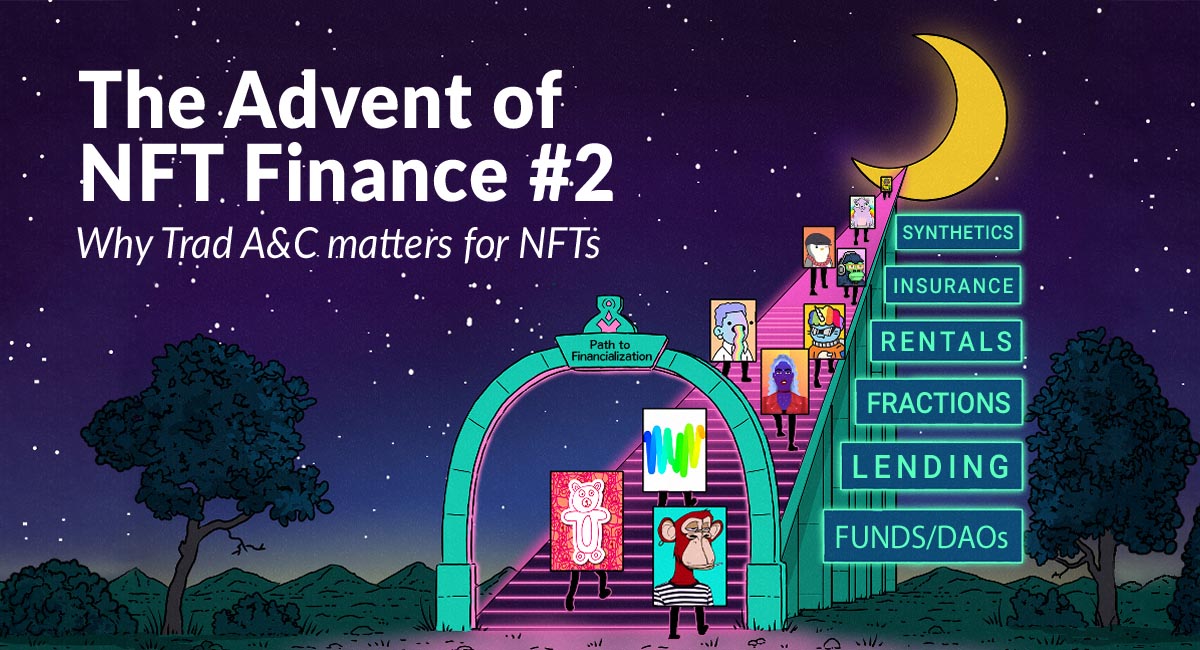
The second in a series of articles exploring the systemic impact of NFT Finance on the mass adoption of NFTs — within the Art & Collectibles vertical and beyond. A research collaboration with CADLabs.
By Giulio Trichilo and Jonathan Gabler
INTRODUCTION
In this article we begin by breaking down the panoptic view of the NFT space introduced in Article 1. We do this from a first-principles approach — starting with the Traditional Art & Collectibles (Trad A&C) market and how it relates to today’s NFT A&C market. We probe into the main motivations that underlie collector psychology, consider how these motivations relate to collecting in both Trad and NFT A&C contexts, and attempt to answer why markets form in the first place.
We then take a small step back to compare the size of the Trad and NFT A&C markets and their respective Financialization, as well as what this implies about the latter’s potential for scale. With this crucial context established, we turn to analyzing collector activity, with a focus on how HNWIs/whales influence market dynamics and currently dominate Financialization. We conclude with an examination of the overlap in services and value-unlocking opportunities between Trad A&C Financialization and NFT Finance, as well as offering important insights into how they might differ.
THE APPEAL OF ART & COLLECTIBLES
Most literature about collector psychology [1, 2, 3, 4] seems to agree on a fundamental observation — that the appeal of art and of collectibles is intrinsic to human nature. This appeal is a unique one, existing across all demographics and not subject to variables such as income, location or expertise in any particular occupation. The appeal of fine art, for example, is also deeply personal, although trends do play a role in determining collecting practices.
The appeal of holding or trading Art & Collectibles is typically a trade-off between emotional and financial motivations, as befits their common categorization as passion assets [5]. The main categories of such motivations are as follows:
- Enjoyment of Ownership: Collectors may exhibit art and other items in their collection either privately or publicly, for personal enjoyment and/or broader value signaling. By contrast, holding traditionally fungible assets such as stocks and bonds does not offer the same object-led opportunities for personal and public appreciation. In the NFT A&C space, the ‘PFP-fication’ of anonymous twitter profiles based on ownership of particular ERC-721 tokens from the CryptoPunks or BAYC collections is a strong representation of this phenomenon.
- Social Networking: Collectors are often members of communities made up of people with similar interests, or can insert themselves in existing circles through their collecting. This often manifests through the attendance of events, primarily based around the international art fair and festival circuit. It is also a direct route onto museum boards and provides access to other prestigious non-profit, high-clout organizations. Immediate social validation is provided on the basis of the extent and perceived significance of a person’s collection. Being a collector is therefore typically associated with the construction and maintenance of social circles. This is particularly true for NFTs, where recent phenomena such as DAO membership certification via NFT holding are becoming more commonplace.
- Privacy: Most of the Art & Collectibles market is unregulated, unlike securities markets where records of transactions are recorded. Transactions in Trad A&C are generally confidential and unrecorded or privately recorded. The novelty in the NFT A&C space is that these are all public, hence the privacy aspect falls back on the anonymity of the collector themselves, who may spread their collection across multiple wallets. The rise of privacy-focused scaling solutions for layer 1 chains like Ethereum, or privacy-focused chains, may return this factor to its original appeal.
- Investment & Store of Value: In financial terms, the global collectibles market has historically had a low correlation with capital markets (0.5–0.6) [6]. However, Trad A&C is often marketed as an investment opportunity and an investment in a varied set of collectibles could be an effective way to diversify a portfolio whose constituents are otherwise traditionally liquid assets. This is certainly true in the NFT A&C space, where the longest-lived collections to date have provided outsized returns and there is an optimistic attitude among market participants.
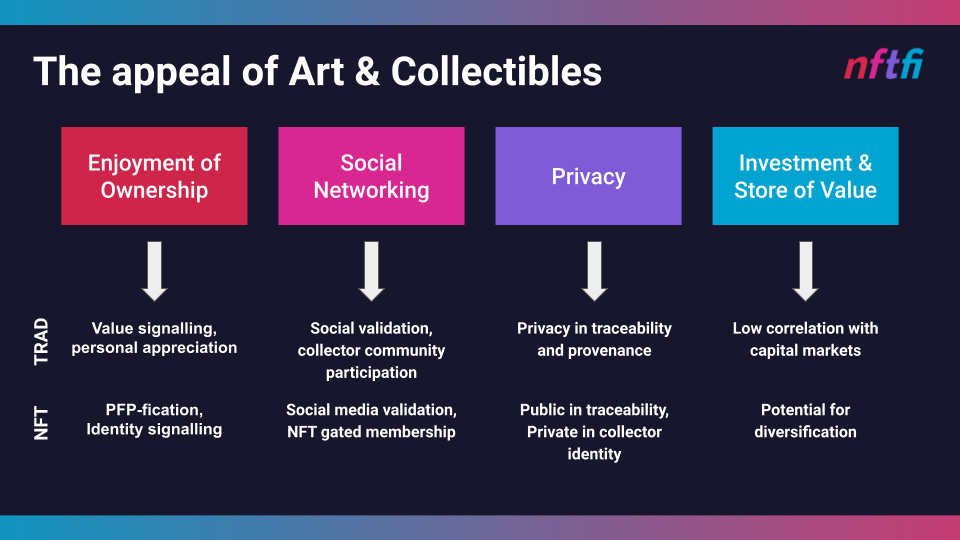
As for the why behind the formation of A&C markets in the first place, the reality is that it has been a feature of society since antiquity. A combination of the factors above and a core ‘collecting instinct’ have led societies to want to collect and display items, with the trade for these assets naturally following suit. The existence of A&C markets is therefore inevitable, given the need for appropriate venues of exchange to satisfy collectors’ buying and selling demands.
From this analysis, we can establish that the primary motivations that have inspired collectors in the Trad A&C space continue to motivate NFT A&C collectors and that the complex appeal of collecting transcends physical and digital boundaries. These conclusions demonstrate the value of continuing to compare the two markets and confirm that they share similar foundations based on the timeless human impulse to collect. We argue that it is important to understand these dynamics for a holistic view of the NFT A&C space and furthermore, that these psychological insights indicate the NFT A&C market is not a speculative bubble but will continue expanding and have longevity.
However, to understand the NFT A&C market’s potential for growth, and the associated potential of NFT Finance, we first need to contextualize the current size of both markets in relation to their closest equivalents: Trad A&C and Trad A&C Financialization. We break this down in the following section.
THE SCALE OF ART & COLLECTIBLES
The Deloitte 2019 Art & Finance report found that the Trad A&C market, in terms of asset market cap, is valued at roughly $1.7T [14], with 3%-4% of this value being traded yearly [20], putting yearly trading volume at roughly $70B. According to a 2021 report from Chainalysis, the NFT market is, by trading volume, worth roughly $40B, hence already almost 60% of the size of Trad A&C [9]. While it is important to note that this $40B figure covers the entire NFT market, the A&C vertical is by far the largest sub-vertical: three quarterly studies from nonfungible.com [10, 11, 12] categorized NFTs into 6 verticals, where, by volume, A&C made up 91% of the market in Q1 of 2021, 80% in Q2, and 85% in Q3.
But what about the respective levels of Financialization in Trad A&C and the NFT market? According to the 2019 Deloitte Art & Finance Report, the Financialization of Trad A&C stands at roughly $24B — about 34% of the overall Trad A&C market size. Notably, the report finds the main contributor to the size of this space to be art-secured lending, a service traditionally primarily offered to HNWIs. In a brief “back-of-the-envelope” market sizing analysis, we estimated the size of NFT Finance, as per February 2022, at not more than $200M¹ — about 0.5% of the overall NFT market.
While emerging NFT Finance market analytics will soon provide a clearer picture, the above number suggests that the young NFT space, in terms of trading volume, is growing much quicker than Trad A&C, and will likely eclipse it very soon. At the same time, the NFT Financialization levels are minuscule (est. 0.5%) compared to Trad A&C (est. 35%), confirming what’s obvious — that NFT Finance is in its absolute infancy and has ample room to grow.
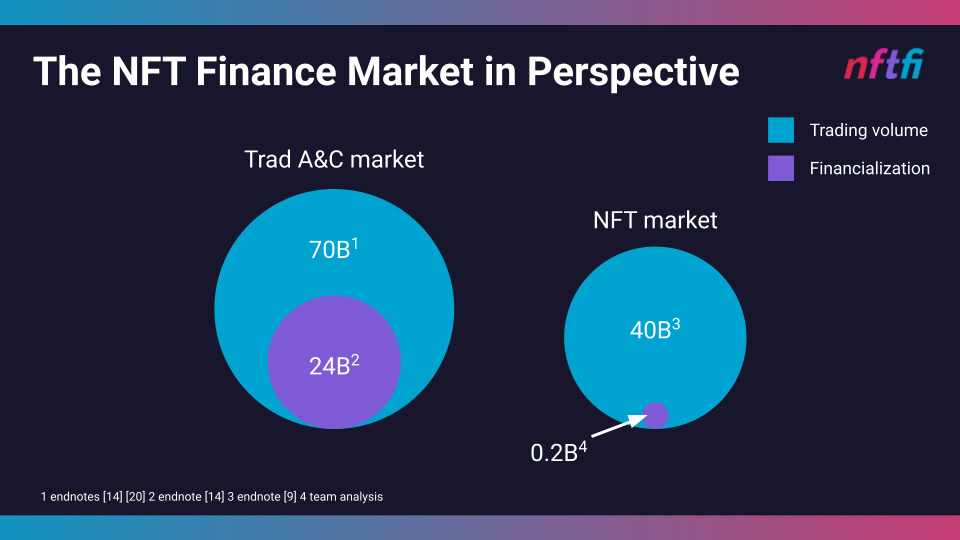
COLLECTORS, INVESTORS AND COLLECTOR-INVESTORS
In [7], A. Picinati Di Torcello (2010) cites a 2009 report produced by Baird Asset Management that defines three types of collectible buyers: pure collectors, collector/investors and pure investors for whom buying collectible assets is a financial game. The report further states that the last two categories own ⅓ of total collectibles. As we argued at the start of this article, the appeal of collecting exists regardless of context, whether digital or physical. We will now expand on this to show that the full range of collecting intent described above, from pure collecting to pure investing, is also present in both Trad and NFT A&C, through analyzing whale/HNWI activity.
A study from Nansen.ai with a specific focus on the CryptoPunks NFT collection finds definitively that the market is dominated by whales. While CryptoPunks are not representative of the entire A&C NFT space, this collection accounted for over 90% of trading volume out of the entire ‘collectibles’ category in Q1 2021 as per Nonfungible.com [10] and is therefore an indicative sample of market activity.
The study reports that the top 5 CryptoPunks holders are original collectors and own 14% of the total number of punks. However, the study also finds that the grip on the collection by large holders is loosening — from 300 unique addresses holding tokens in the collection in July 2017 to 3,000 in July 2021. This suggests a broader, widening market participation.
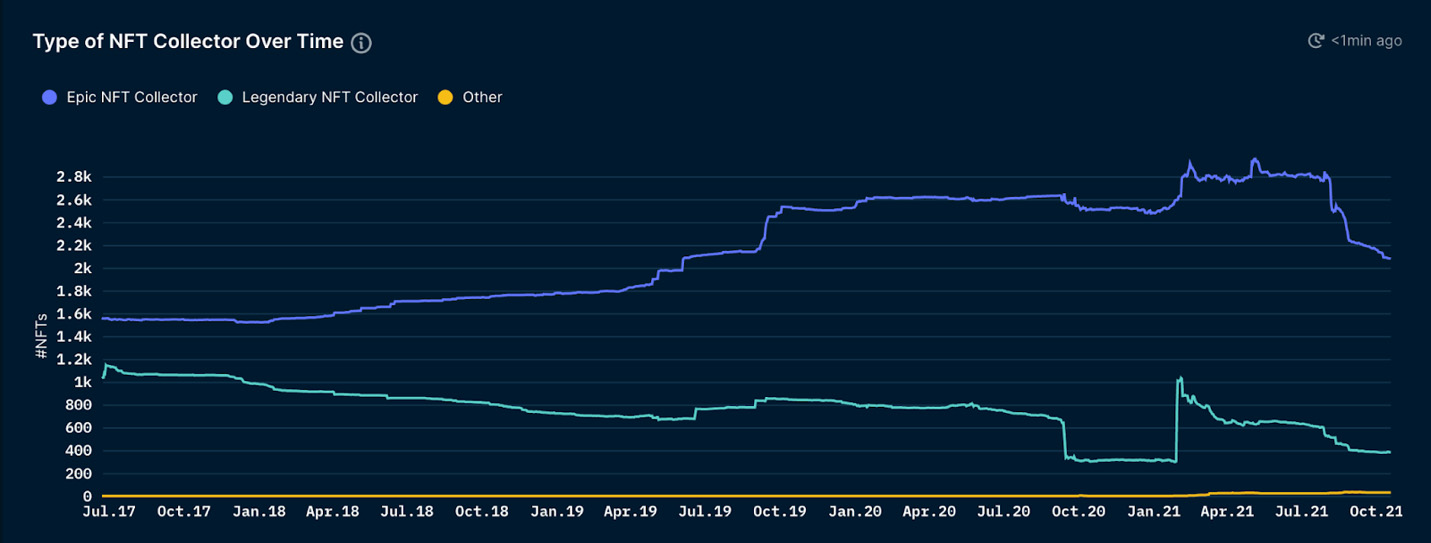
Evolution of CryptoPunk holder distribution in terms of holder segments, Nansen.ai [8]
This graph traces the evolution of CryptoPunks’ holder distribution over time and shows that the number of trades made by ‘Legendary’ NFT collectors (defined as top 0.1% in terms of ERC-721 transactions made) are accounting for progressively less of the total volume of the collection. This means that other parties, such as ‘Epic’ NFT collectors (no threshold provided) are moving into the collection. It’s interesting to note that the ‘Other’ category — which includes retail ownership — pales in comparison to the other two collector categories, although it has also begun to rise since 2021. We do not have sufficient data to conclude whether this implies a shift along the ‘collecting intent’ spectrum from pure collectors to collector/investors or pure investors. However, the evident broadening in market participation demonstrated above could potentially be a proxy for this.
In Article 1, bolstered by our investigation into the appeal of collecting at the start of this article, we explained that Trad A&C markets are dominated by the wealthy and well-connected. We have also just established that NFT A&C markets are typically whale-centric. Now we will consider whether this dominance carries over into both markets’ Financialization.
For Trad A&C, reports certainly show that the market for financial services and products based on A&C is hugely dominated by HNWIs [14]. Due to the lack of comparative data and analysis currently available on whale movements within NFT Finance, it is hard to make a direct comparison here. However, this in itself raises the interesting question of whether NFT Finance will adopt the same dynamic of limited, HNWI-focused participation? We cannot assess this with certainty, as HNWI-focused markets exist for all major asset classes, but we can point to the potential for new financial primitives within NFT Finance to be better suited to an inherently wider market participant base.
With the aim of exploring this potential and keeping in mind the psychological and practical parallels drawn between Trad and NFT A&C collectors and markets, we turn to consider the nature of Financialization and its opportunities for value-unlocking in relation to both markets. We believe this research and the points of both similarity and difference raised can offer important insights into the future development of NFT Finance.
UNLOCKING VALUE IN ART & COLLECTIBLES — FINANCIALIZATION AND NFT FINANCE
First, we will briefly consider how Financialization in Trad A&C emerged and how we define it, before outlining some key use cases, benefits and considerations.
There has been increasing interest in Trad A&C from the financial industry due to its potential as an ‘alternative’ asset class. Financial institutions, specialized boutiques, and family offices, to name a few, are all developing and expanding ‘art services’ [7]. These non-traditional services belong to the broader subcategory of services concerned with the Financialization of alternative investments, that is to say Specialty Finance [15].
While Trad A&C are typically considered illiquid alternative real assets, the fact that these may be used for investment purposes, does not in itself imply ‘Financialization’. Our definition of Financialization includes the creation of infrastructure which allows for non-fungible assets like most collectibles, and which can include digital collectibles like NFT A&Cs, to be tapped into for personal or professional financing needs.
The most prevalent example of this kind of infrastructure in Trad A&C Financialization is that which enables loans to be taken out against a non-fungible asset, e.g. a high value artwork which is used as collateral. In practice, if a non-fungible asset such as an ERC-721 collectible can be involved in the creation of a cash flow between parties, constructing a product to allow this constitutes a specific example of Financialization for the asset in question.
As a borrower, it may be beneficial to leverage ‘Financialized’ market infrastructure, whether as a HNWI wanting to borrow against their painting and use the credit line for setting up a new business, or in more accessible terms as an NFT holder wanting to borrow against their (second) favorite generative piece from Art Blocks and use the credit line to repay a previous outstanding commitment.
This is an example of ‘debt-like’ Financialization, which we’ll talk about in more depth in Article 5. Currently, art-collateralized loans are typically in the form of revolving debt [16] or bullet loans [17]. In an opinion on the likelihood of demand for these services, [16] states that “it seems inevitable that financial institution lenders will be approached by customers seeking to put up newly minted NFT-linked art collections as collateral”.
Since the art-lending market is composed of a very concentrated set of well capitalized borrowers, the credit risk on these facilities is generally perceived as relatively low. By contrast, creditworthiness assessment in the NFT space is still in its very early stages. To gauge credit risk one must go through an NFT and DeFi protocol “daisy chain” of sorts where multiple protocols piece together a user’s financial reliability, each from their own angle [18]. On the one hand, this attests to the blockchain paradigm of composability being able to make a solution manifest without a centralized intermediary creating a bespoke solution. On the other hand, it is hard to qualify such a ‘daisy chain’ as ‘infrastructure’ quite yet.
CONCLUSION
Throughout this article, many points of comparison between Trad and NFT A&C markets have been considered, with positive implications for the scope and development of NFT Finance — particularly with regards to scale and participation.
We began by broadly characterizing collector psychology and breaking down the main factors that influence collecting activity in Trad A&C. We compared these dynamics to the NFT A&C market, drawing direct comparisons between, for example, the appeal of social networking in Trad A&C and the phenomena of NFT PFP-fication. Turning from the motivations to the practicalities of collecting, we analyzed the holding distribution of the CryptoPunks collection and argued that the increase in holder addresses from large whales to a slightly broader collector base could be interpreted as a proxy for a shift in collecting intent from pure collectors to a more investor-collector driven market.
Focusing our attention on Financialization for Trad and NFT A&C, we established that there is a significant overlap in terms of what products are and can be offered, although crucially the design space for Web3 financial primitives is larger, due to the target investor base in NFT Finance as a whole being comprehensive of more use cases. We propose that this difference in potential usage can be explained in terms of “appeal” and “construction”.
In terms of appeal, popular NFT A&Cs today have both community and trend-based appeal. Furthermore, classes of NFT A&Cs which fall out of the ‘Blue Chip’ designation, such as in GameFi, derive value from being endowed with additional utility that encourages further adoption and integration. In Trad A&C, the lack of such a utility layer is a bottleneck to going mainstream.
With regards to construction, NFT Finance inherently lends itself better to composability, however we must guard against the NFT Finance ‘daisy chain’ becoming overly convoluted. Overly complex composability leads to security risks as well as increasing complexities in transacting with NFT Finance primitives. In Trad A&C, this risk of over-composability is not run, however the market for products in the space is unregulated and bespoke, and hence lacks ‘composability’ all together.
In the next article, we’ll step aside from NFTs and Art & Collectibles altogether, in “TradFi for the Crypto Investor”. This article will provide common ground for readers of all levels of financial literacy to lead into the NFT Finance deep dive in the final article. In Article 4, we will fill in the crucial aspect of how valuation works in Trad A&C, which has significant bearings on its Financialization, and by extension, our attempts to envision the future of NFT Finance.
To get notified once we publish the next article in this series, follow this Medium Publication or leave your email address on NFTfi.com.
FOOTNOTES
¹ This estimate is based on a back-of-the-envelope market sizing analysis based on available data for the projects in Nichanan Kesonpat’s excellent “NFT Financialization Landscape” [19]. The scope of this analysis was not to provide an integral estimate of all facets of NFT Finance, as per categorical disambiguation provided in the original definition, but to provide an estimate in a sensible order of magnitude.
REFERENCES
[1] Wikipedia contributors. (2022, January 28). Psychology of collecting. Wikipedia. https://en.wikipedia.org/wiki/Psychology_of_collecting
[2] Rubin, B. R. (2008). Amass Appeal. AARP. https://www.aarp.org/entertainment/arts-leisure/info-01-2008/amass_appeal.html
[3] Bowman, S. (2011, May 31). The psychology of collecting | The National Psychologist. The National Psychologist | The Independent Newspaper for Practitioners. https://nationalpsychologist.com/2007/01/the-psychology-of-collecting/10904.html
[4] McKinley, M. B. (2010, July). The Psychology of Collecting. https://web.archive.org/web/20100705010009/http://www.talkingclocks.net/collecting.pdf
[5] Porter, T. J. (2022, January 10). Collectibles as Investments in 2022 — Valuable Types, Risks & Rewards. Money Crashers. https://www.moneycrashers.com/collectible-investments/
[6] M. (2021b, December 29). Asset Class Insight Series: Comparing Art and Cryptocurrency. Masterworks. https://www.masterworks.io/insights/asset-class-insight-series-comparing-art-and-cryptocurrency
[7] Picinati Di Torcello, A. (2012). Why should art be considered as an asset class? Deloitte. https://www2.deloitte.com/content/dam/Deloitte/lu/Documents/financial-services/artandfinance/lu-art-asset-class-122012.pdf
[8] CryptoPunks: What’s Behind Their Unstoppable Rise? (2021). Nansen. https://www.nansen.ai/research/cryptopunks-whats-behind-their-unstoppable-rise
[9] The NFT Market Report. (2021). The Chainalysis 2021 NFT Market Report. https://go.chainalysis.com/nft-market-report.html
[10] NonFungible.com. (2021a, March). NON-FUNGIBLE TOKENS QUARTERLY REPORT Q1 2021. https://nonfungible.com/subscribe/nft-report-q1-2021
[11] NonFungible.com. (2021b, June). NON-FUNGIBLE TOKENS QUARTERLY REPORT Q2 2021. https://nonfungible.com/subscribe/nft-report-q2-2021
[12] Q3 2021 NFT Quarterly Report. (2021). NonFungible.com. https://nonfungible.com/nft-report-q3-2021
[13] Masterworks. (2020, November). Understanding Art as an Investment [Slides]. PDF. https://assets.ctfassets.net/u7fuap5iqsvx/Yl5AJQD1mtKDMbs9V9GjP/02d2cc5af96cb48fb741814f3ab7b667/Masterworks_Art_as_an_Investment__November_2020_.pdf
[14] Deloitte. (2019). Art & Finance Report 2019 (№6). https://www2.deloitte.com/content/dam/Deloitte/lu/Documents/financial-services/artandfinance/lu-art-and-finance-report-2019.pdf
[15] Grant, D. (2019, February 4). Savvy Specialty Finance Firms Cash in on the Growing Trend of Borrowing Against Art. Observer. https://observer.com/2019/02/fine-art-group-acquisition-shows-art-lending-growth
[16] Non-Fungible Tokens (NFTs) as Art Loan Collateral. (2021, April 9). Business Law Today from ABA. https://businesslawtoday.org/2021/04/non-fungible-tokens-nfts-art-loan-collateral/
[17] Charlin, V., & Cifuentes, A. (2019). A Risk-Assessment Framework for Art-Secured Lending. https://doi.org/10.2139/ssrn.3334756
[18] Economic Primitives of the Metaverse 2: Mortgages. (2021, December 1). Blockchain@Columbia. https://blockchain.mirror.xyz/MZmMEDUckY5Vo3QMwZPHcgcSr_FTpg1X025VUad_s9o
[19] Kesonpat, N. (2022, February 22). Show me the Liquidity: Evaluating NFT Financialization Methods. https://medium.com/1kxnetwork/show-me-the-liquidity-evaluating-nft-financialization-methods-f3c30bf8f08c
[20] Investing in the Art and Collectables Market: A $1.7 Trillion Asset Class. (2021, August). Nomura. https://www.nomuraconnects.com/focused-thinking-posts/investing-in-the-art-and-collectables-market-a-1-7-trillion-asset-class
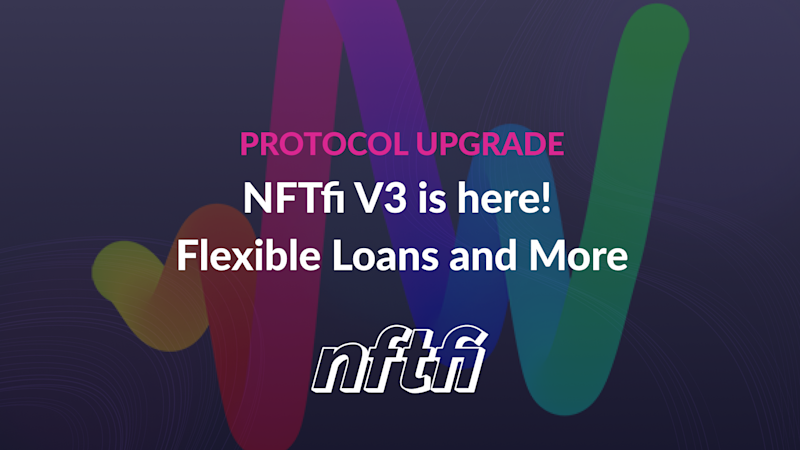
October 08, 2024
NFTfi V3 is here! Flexible Loans and More
NFTfi V3 is the best version of your favorite NFT lending protocol. The highlight of this protocol upgrade is the introduction of Flexible Loans. Now, borrowers can choose a new loan type called “Flexible Loan.” Under flexible loans, they only repay the prorated interest instead of the full interest, as they did before. In other words, borrowers will have the option to pay only for the interest they use.
Learn more >
October 08, 2024
NFTfi Aggregator: Your NFT Lending Command Center Is Live
NFTfi V3 is the best version of your favorite NFT lending protocol. The highlight of this protocol upgrade is the introduction of Flexible Loans. Now, borrowers can choose a new loan type called “Flexible Loan.” Under flexible loans, they only repay the prorated interest instead of the full interest, as they did before. In other words, borrowers will have the option to pay only for the interest they use.
Learn more >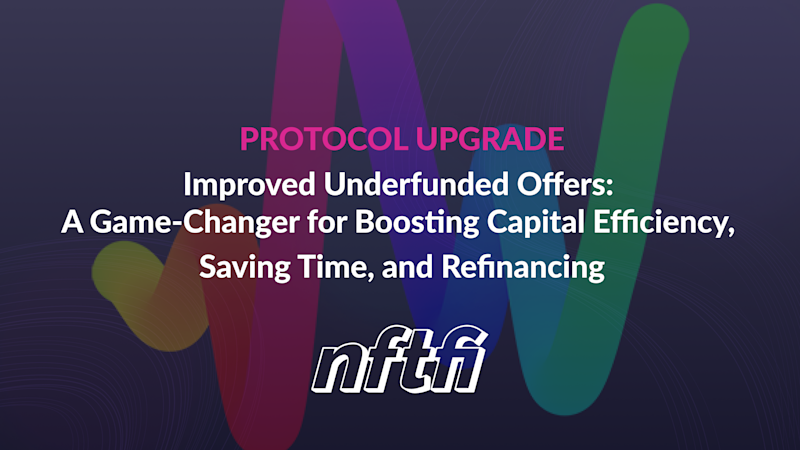
July 30, 2024
Improved Underfunded Offers
We have significantly enhanced the loan offer functionality on NFTfi, allowing lenders to make offers even when they do not have sufficient funds in their wallets. This improvement helps lenders boost their capital efficiency and save time, especially when refinancing a loan.
Learn more >